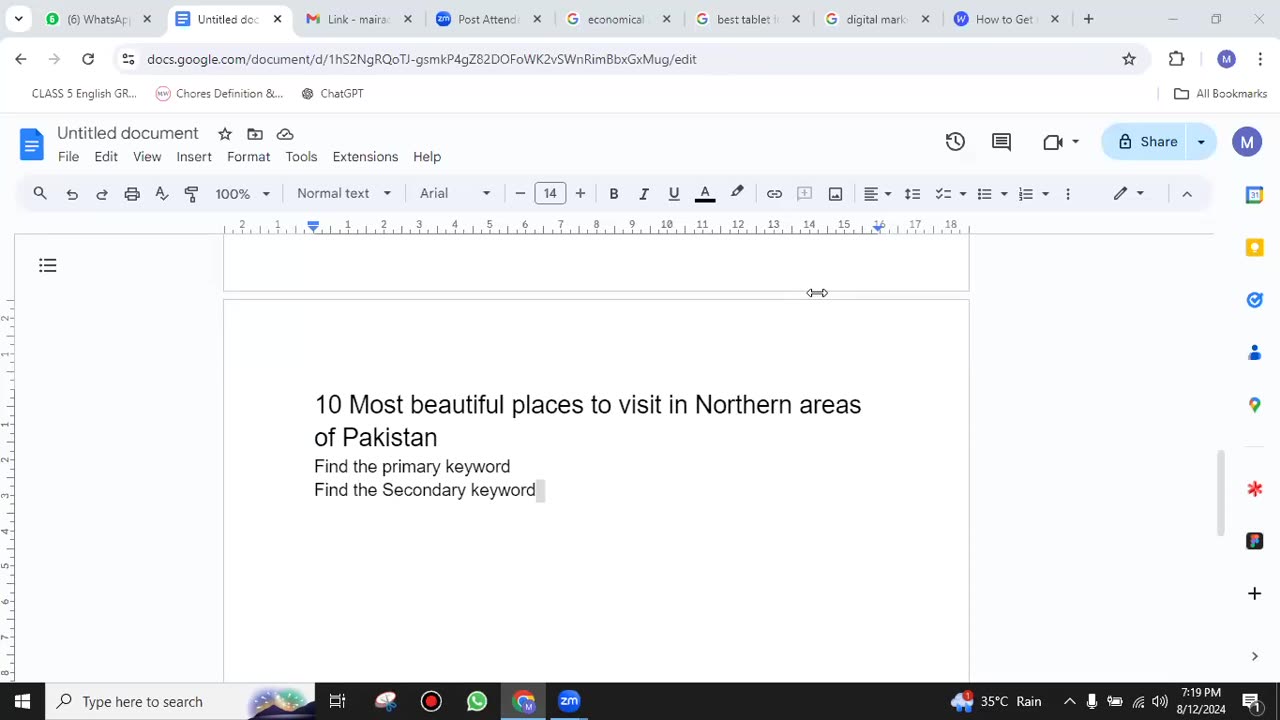Premium Only Content

Lect#4 SEO Content Writing By Miss Maira Qureshi #LWE Batch#103-104
Keyword research is a crucial step in SEO that involves identifying and analyzing the search terms that people use when looking for information, products, or services online. Here’s a breakdown of the process and some best practices:
### Steps for Effective Keyword Research
1. **Identify Your Goals**:
- Define what you want to achieve (e.g., increased traffic, lead generation, sales).
- Understand your target audience and their needs.
2. **Brainstorm Seed Keywords**:
- Start with broad topics relevant to your business or niche.
- Think of words or phrases your audience might use.
3. **Use Keyword Research Tools**:
- Utilize tools like:
- **Google Keyword Planner**: Offers keyword suggestions and search volume.
- **Ahrefs**: Provides keyword ideas, difficulty scores, and search volume.
- **SEMrush**: Offers a comprehensive keyword database and competitive analysis.
- **Ubersuggest**: A user-friendly tool for finding keyword ideas.
- **Answer the Public**: Generates questions and phrases based on a keyword.
4. **Analyze Keywords**:
- **Search Volume**: Look for keywords that have a substantial number of searches.
- **Keyword Difficulty**: Assess how competitive a keyword is. Lower difficulty scores are usually better for new sites.
- **Relevance**: Ensure the keywords align with your content and audience intent.
5. **Consider User Intent**:
- Determine the intent behind the searches:
- **Informational**: Users seeking information (e.g., "how to cook pasta").
- **Navigational**: Users looking for a specific website (e.g., "Facebook login").
- **Transactional**: Users intending to make a purchase (e.g., "buy running shoes").
6. **Long-Tail Keywords**:
- Focus on longer, more specific phrases (e.g., "best running shoes for flat feet") as they often have lower competition and higher conversion rates.
7. **Competitive Analysis**:
- Analyze the keywords your competitors are ranking for using tools like Ahrefs or SEMrush. Identify gaps and opportunities.
8. **Organize Your Keywords**:
- Create a spreadsheet to categorize keywords by topic, search volume, difficulty, and intent. This helps in planning content and optimizing existing pages.
9. **Monitor and Adjust**:
- After implementing your keywords, regularly track their performance. Use tools like Google Analytics and Search Console to measure traffic and engagement.
### Best Practices
- **Focus on Relevance**: Always prioritize keywords that are relevant to your content and audience.
- **Diversify Your Keywords**: Use a mix of head terms (broad keywords) and long-tail keywords to cover different aspects of your niche.
- **Optimize Content Accordingly**: Integrate your keywords naturally into titles, headings, meta descriptions, and throughout the content without keyword stuffing.
- **Stay Updated**: Keyword trends can change, so regularly revisit and update your keyword strategy based on performance and shifts in user behavior.
By following these steps and best practices, you can develop a robust keyword strategy that enhances your SEO efforts and drives targeted traffic to your website.
-
 LIVE
LIVE
vivafrei
9 hours agoEp. 279: Patel's GF Sues for Defamation! Rogue Judges vs. Trump! Raja Jackson, Kick Stream & MORE!
15,171 watching -
 LIVE
LIVE
SpartakusLIVE
39 minutes ago#1 Verdansk Sniper gets HACCUSATIONS because of INSANE Headshots
111 watching -
 18:52
18:52
Colion Noir
6 hours agoCourt Rules You Don't Need AR-15s For Self Defense, Mayor's Message If You Love Kids Ban AR-15s
4.36K27 -
 LIVE
LIVE
Nerdrotic
2 hours ago $1.03 earnedThe Mysteries of Mars and the Moon with Mike Bara | Forbidden Frontier #114
510 watching -
 LIVE
LIVE
The Mel K Show
1 hour agoMel K & Chas Holloway | An Opposing Theory: The AI & Tyranny Question | 8-31-25
194 watching -
 LIVE
LIVE
Rallied
1 hour ago $0.45 earnedSolo Challenges All Day
202 watching -
 UPCOMING
UPCOMING
IsaiahLCarter
2 days agoGrandmasters and Heretics || APOSTATE RADIO #027
13 -
 3:03:40
3:03:40
Barry Cunningham
6 hours agoPRESIDENT TRUMP IS THE TROLLER-IN-CHIEF AND MORE BREAKING NEWS!
23.7K22 -
 13:07
13:07
Robbi On The Record
3 hours ago $1.48 earnedSweet Poison: The Big Fat Lie That’s Killing America
6.68K5 -
 1:00:09
1:00:09
Sarah Westall
2 hours agoFlorida Surgeon General: Operation Warp Speed plus Attacks on RFK Jr w/ Dr Ladapo
10.7K8